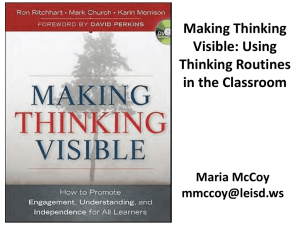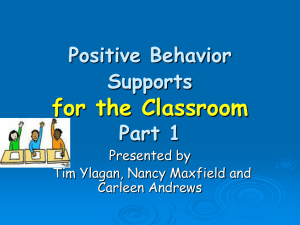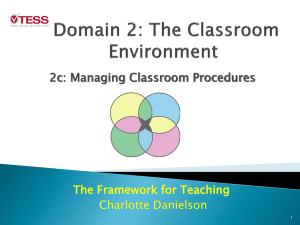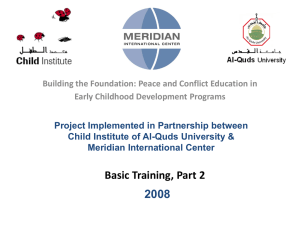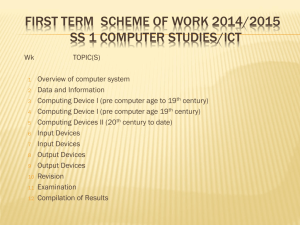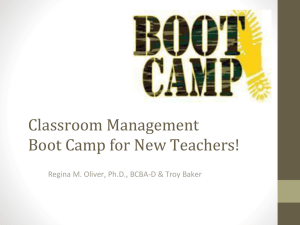Family Routines and Rituals
advertisement
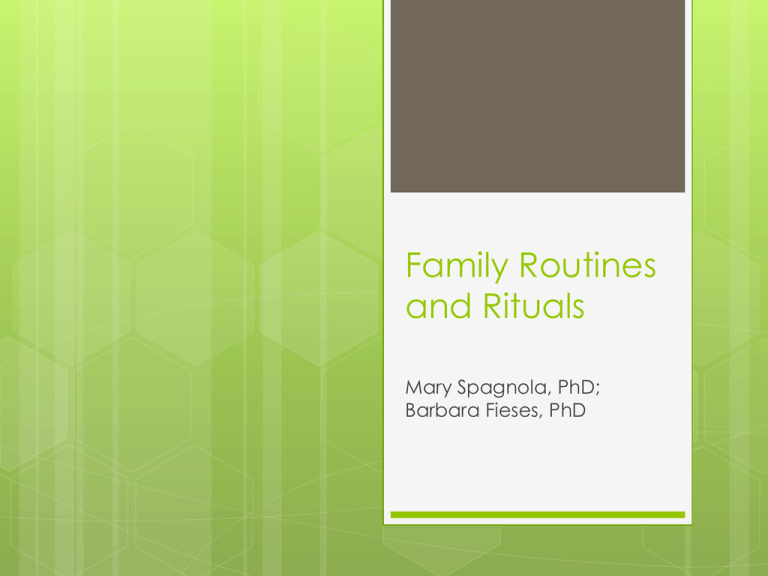
Family Routines and Rituals Mary Spagnola, PhD; Barbara Fieses, PhD Family Routines and Rituals Routines and rituals provide predictable structure that guides behavior and emotional structure that supports early development. Variations in the practice of routines and the meanings connected to rituals are associated with variations in socioemotional, language, academic, and social skill development Family Routines and Rituals Routines and Rituals- Both refer to specific, repeated practices that involve 2 or more family members. Routines- Communication is instrumental, monetary time commitment involved, and are repeated regularly. They hold no special meaning. Rituals- Communication has symbolic meaning, the time commitment and continuity of the ritual continues through generations. Dinnertime Features of both routines and rituals Some practices do not have special meaning Meaningful and symbolic elements Distributing food, doing dishes, etc. Saying grace, eating certain foods, telling stories Rituals are distinct and unique to a particular family, reflecting family identity, culture, and shared values. Family Routines and Language Routines are often rich with language, exposing children to a broad range of its use. Narratives Explanations Clarifications Cultural rules Meta- Language- draws the listener’s attention to language by using terms such as “say, ask, talk, and read” Common at the dinner table Academic Skill Development Reading routines support development of early literacy skills. Encourages continued enjoyment of reading into school years Joint book reading Routines with book reading Family routines ease transition to school by teaching what will be culturally expected in school. Social Skill Development Routines and Rituals provide a structure for the socialization of culturally acceptable behavior. Preschool years- begin making choices about routines and practice new skills. Cultural differences Foster skill development and connections with others Family Routines, Rituals, and Relationships Family rituals and relationship satisfaction during the transition to parenthood are associated Variations in family interaction patterns at ritual gatherings are related to child socioemotional functioning. Marital Satisfaction and Family Stability New parents must learn to integrate feeding, bathing, and naptime routines into their lives These routines are established easier when the marital bond is stronger. Routines and Rituals evolve over time. “Couplehood” to “Parenthood” Parents of infants report fewer rituals and less investment in them than parents of preschoolers Marital Satisfaction and Family Stability Marital stability is associated with healthy child socioemotional adjustment. Family routines and rituals are associated with the quality of the marital relationship. Mothers of preschoolers reported less satisfaction in their marriage when little meaning was associated with their family rituals Divorce Divorce disrupts family life Less family stability and consistency Routines and rules may be different in each home. Parents who resolve their differences and agree on a set of rules and routines in both homes, provide the most stability for their child. Meaningful rituals may protect children from the disruptions associated with divorce. Emotional Investments Repeated family gatherings offer the opportunity to create strong emotional bonds. Dinnertime conversations Single Parents- more social interaction with children. Married Parents- spend 25% of mealtime talking to each other Routine gatherings form the foundation for rituals that are built on emotional connections. Family Transactions and Routines Parent must adjust routines and rituals to particular child. The child contributes to the regulation of family life. It takes time to develop routines. A pattern or routine that works for one child may not work for another child. Dynamic interplay of the individual characteristics of the children and the parents that form the collective routines of family life. Transaction Model Example Parent Worry & Concern Parent Style Observant Establish back rub routine Parent feels confident Child Biological Rhythms Heart Beat Calmed by back rub Settled to sleep Regular sleep cycle Transaction Model Example Parent Intrusive interaction style Persistence and coaxing Gives up routine Child Feeding difficulty Disengage and food refusal Tantrum Social skill impairment Mechanism of Effect Three mechanism of effect are associated with the creation of predictable routines. Parental efficacy Behavior monitoring Coherence of family relationships Predictable and regular routines mediate the effects of parental efficacy on positive child outcomes Parental Efficacy Important for families with young children. Mothers of infants felt more competent with their parenting role if they reported regular household routines. Parents who engage in more daily caregiving routines More comfortable with the tasks Greater sense of accomplishment Routines more likely to continue over time Behavior Monitoring Monitoring is an important part of family routines More active monitoring decreases risky behaviors in children Parents who feel competent in carrying out routines may be better equipped to track their children’s activities. Coherence and Family Relationships The symbolic nature of family rituals and the emotional connections that are made over time. Adaptive family functioning-rituals promote forming trustworthy and reliable relationships Ritual Meaning Quality of Life Assessment for young children Questionnaires Advantages Disadvantages Not as useful for interventions Direct Observations Time and cost efficient Stronger psychometrics Comparisons across groups Observational methods can involve direct or videotaped observations of families carrying out daily routines. Interviews Families can clarify and expand on meaning of practices Track across generations Interventions Remediation Changes the way the child behaves toward the parent. Redefinition Changes the way the parent interprets the child’s behavior. Reeducation Changes the way the parent acts with the child through increased knowledge. Conclusion Families can identify activities that they regularly engage in, look forward to, and would miss if not regularly practiced as a group. Routines and rituals ease transitions and foster a sense of autonomy while maintaining connections with the family. Crash in the Andes The survivors became a family Routines Assigned tasks Food Rationing Sleep Assignments and Rotation Rituals Nightly Rosary
